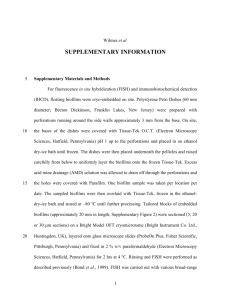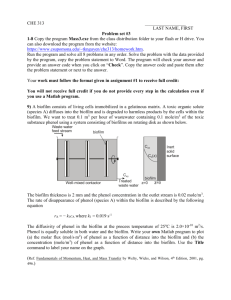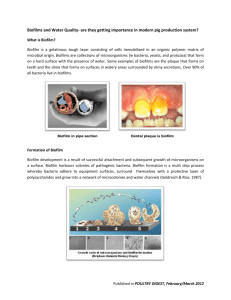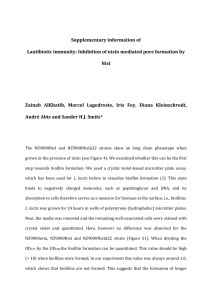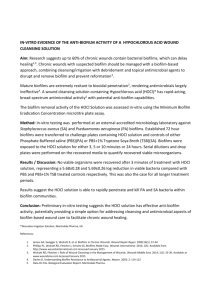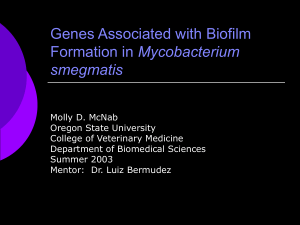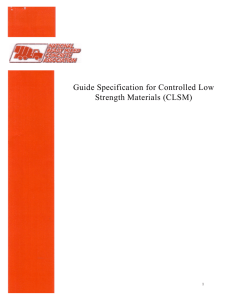Supplementary information (doc 54K)
advertisement
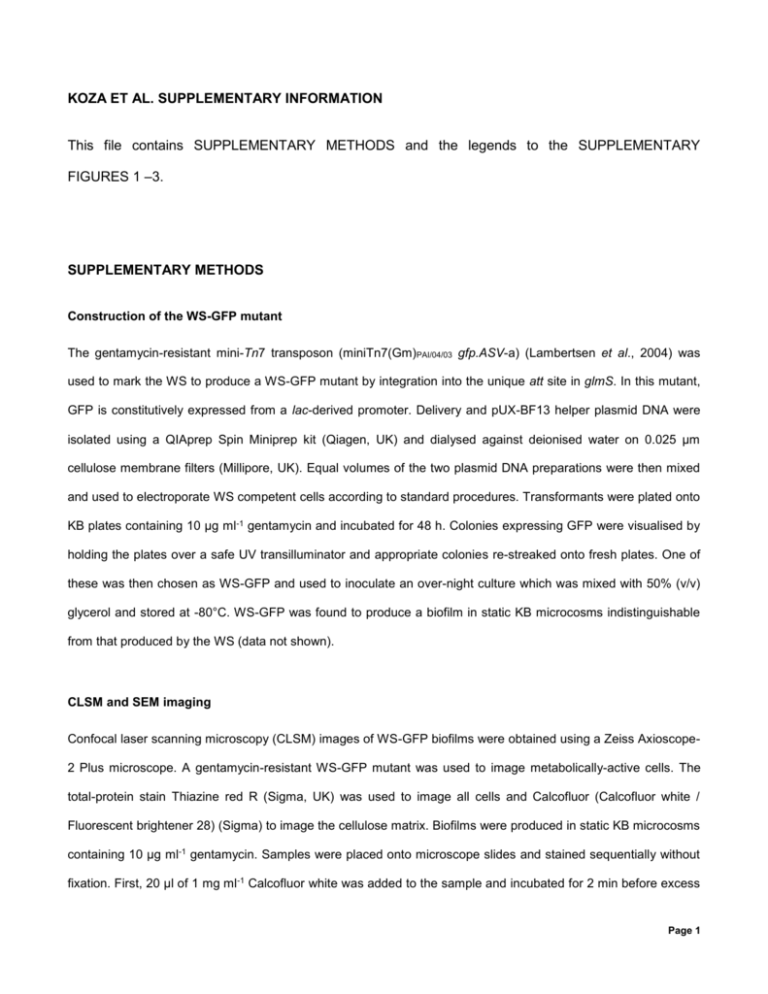
KOZA ET AL. SUPPLEMENTARY INFORMATION This file contains SUPPLEMENTARY METHODS and the legends to the SUPPLEMENTARY FIGURES 1 –3. SUPPLEMENTARY METHODS Construction of the WS-GFP mutant The gentamycin-resistant mini-Tn7 transposon (miniTn7(Gm)PAI/04/03 gfp.ASV-a) (Lambertsen et al., 2004) was used to mark the WS to produce a WS-GFP mutant by integration into the unique att site in glmS. In this mutant, GFP is constitutively expressed from a lac-derived promoter. Delivery and pUX-BF13 helper plasmid DNA were isolated using a QIAprep Spin Miniprep kit (Qiagen, UK) and dialysed against deionised water on 0.025 µm cellulose membrane filters (Millipore, UK). Equal volumes of the two plasmid DNA preparations were then mixed and used to electroporate WS competent cells according to standard procedures. Transformants were plated onto KB plates containing 10 µg ml-1 gentamycin and incubated for 48 h. Colonies expressing GFP were visualised by holding the plates over a safe UV transilluminator and appropriate colonies re-streaked onto fresh plates. One of these was then chosen as WS-GFP and used to inoculate an over-night culture which was mixed with 50% (v/v) glycerol and stored at -80°C. WS-GFP was found to produce a biofilm in static KB microcosms indistinguishable from that produced by the WS (data not shown). CLSM and SEM imaging Confocal laser scanning microscopy (CLSM) images of WS-GFP biofilms were obtained using a Zeiss Axioscope2 Plus microscope. A gentamycin-resistant WS-GFP mutant was used to image metabolically-active cells. The total-protein stain Thiazine red R (Sigma, UK) was used to image all cells and Calcofluor (Calcofluor white / Fluorescent brightener 28) (Sigma) to image the cellulose matrix. Biofilms were produced in static KB microcosms containing 10 µg ml-1 gentamycin. Samples were placed onto microscope slides and stained sequentially without fixation. First, 20 µl of 1 mg ml-1 Calcofluor white was added to the sample and incubated for 2 min before excess Page 1 liquid was drawn off. This process was then repeated using 1 mg ml-1 thiazine red followed by the addition of 10 µl of 10 µg ml-1 phenylendiamine in PBS (pH 7.8) anti-bleaching agent. CLSM images were examined using LSM 5 Pascal software (Zeiss) and used to produce cross sectional images of the biofilm. A Jeol JSM 35C Scanning Electron Microscope (SEM) was also used to obtain images of WS-GFP biofilms. Samples were recovered from static microcosms and frozen in liquid nitrogen for 5 min before freeze-drying at -40°C under vacuum for 24 h. The samples were then shadowed with a gold layer of 15 – 20 Å before imaging. SUPPLEMENTARY FIGURE LEGENDS Supplementary Figure 1. Oxygen penetrance is reduced to 100 – 200 µm within 48 h in the static microcosm. Shown are representative experiments recording the development of the oxygen gradient over time in static microcosms inoculated with 104 cells ml-1. O2 profiles were measured before inoculation (circles), after 24 h (triangles) and 48 – 120 h (squares) (these two profiles over-lap one another and cannot be distinguished in this figure). Measurements were taken every 100 µm down the profile of 9,000 µm and the first 1,000 µm are shown (the A-L interface is at 0 µm). O2 concentration is indicated as the percentage of normal O 2 levels in solution (% O2) on the x-axis. Mean ± SE are indicated (n = 2). Supplementary Figure 2. The oxygen gradient bisects the WS biofilm to produce high and low–O2 niches. Shown are five O2 profiles through WS biofilms which clearly show that high–O2 conditions (>1%) are only found in the top 200 µm layer of the biofilm. Measurements were taken every 200 µm down through biofilms with an average depth of ~2.7 mm. In this figure, only the top 1.6 mm of the profiles are shown, with the A-L interface at 0 µm and indicated by the clear arrow (O2 levels remained unchanged below 1.6 mm through to the bottom of the biofilm and into the liquid column below the biofilm). O2 concentration is indicated as the percentage of normal O 2 levels in solution (% O2) on the x-axis. The section indicated by the grey box is shown at higher scale in the inset. In this, mean ± SE are indicated by white circles and error bars (n = 5). Biofilms were five days old when profiled. Page 2 Supplementary Figure 3. WS cells appear not to be evenly distributed through the thickness of the biofilm. Confocal laser scanning microscopy (CLSM) was used to image WS cells within the biofilm. A WS-GFP mutant was used to visualise metabolically-active cells (green), whilst Thiazine red was used to stain all cells (yellow) and Calcofluor used to stain the cellulose-based matrix of the biofilm (blue). Shown is a set of CLSM plan (x-y axes, top) and horizontal (x-z axes, bottom) images obtained from a section of WS-GFP mutant biofilm. A, B and C are plan views 4.5 µm, 9 µm and 29 µm down from the top surface of the biofilm, showing GFP, Thiazine red and Calcofluor signals. (i) is a horizontal image of the biofilm, showing GFP, Thiazine red and Calcofluor signals (the grey line indicates the bottom of the biofilm); (ii) and (iii) are the same as (i), but (ii) shows only the GFP and Calcofluor signals, and (iii) only Thiazine red and Calcofluor signals (Scale bars: 10 µm). Page 3


